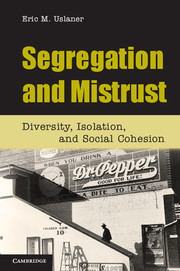Book contents
- Frontmatter
- Contents
- Preface
- 1 Trust, Diversity, and Segregation
- 2 Contact, Diversity, and Segregation
- 3 Building Trust in a Segregated Society
- 4 Canada
- 5 The United Kingdom
- 6 Sweden and Australia
- 7 Altruism and Segregation
- 8 Where You Sit Depends Upon Where You Stand
- 9 The Farmer’s Daughter and Intergroup Contact
- References
- Index
7 - Altruism and Segregation
Published online by Cambridge University Press: 05 November 2012
- Frontmatter
- Contents
- Preface
- 1 Trust, Diversity, and Segregation
- 2 Contact, Diversity, and Segregation
- 3 Building Trust in a Segregated Society
- 4 Canada
- 5 The United Kingdom
- 6 Sweden and Australia
- 7 Altruism and Segregation
- 8 Where You Sit Depends Upon Where You Stand
- 9 The Farmer’s Daughter and Intergroup Contact
- References
- Index
Summary
[I]f any provide not for his own, and specially for those of his own house, he hath denied the faith, and is worse than an infidel.
Timothy 5:8, King James BibleSecond Degree (of charitable giving on an eight-degree ladder): “The Giver and Receiver Unknown to Each Other”: One who gives charity to the poor without knowing to whom he gives and without the poor knowing from whom they take. This is how it was done in the Lishkat Hashaim (Chamber of Charity) in the Temple of Jerusalem.
Moses ben Maimonedes, Maimonides’ Ladder of Tzedakah (Charity)Joining civic groups may not depend upon trust or create it (Claibourne and Martin, 2000; Stolle, 1998; Uslaner, 2002, ch. 5). However, there are two civic activities that both draw upon trust and lead to greater faith in others in turn – giving to charity and volunteering (Uslaner, 2002, ch. 5). Volunteers reject materialistic values in favor of ideals such as a world at peace, inner harmony, and true friendship (Mahoney and Pechura, 1980, 1010; Williams, 1986, 167). They don’t expect anyone to repay their kindness (Gerard, 1985, 237). Their acts of altruism have a spiritual rather than an economic payoff, what Andreoni (1989) calls a “warm glow.” Such acts of kindness are part of the same value system as trust (Rahn and Transue, 1998, 551). So the conditions that lead to trust, including living in diverse, integrated neighborhoods with friends of different backgrounds, should also increase the likelihood of doing good deeds such as giving to charity and volunteering time.
Not all forms of charitable giving and volunteering time are the same. You can spend time at your child’s school: As Sara Mosle wrote: “a lot of what passes for volunteering used to be called simply ‘parenting’: people helping out in their own children’s schools or coaching their own children’s soccer teams” (2000, 25). Or you can volunteer at your church, your synagogue, your mosque, or your temple, or donate money to them. In each of these cases, you are doing good deeds and following the dictates of your faith.
Information
- Type
- Chapter
- Information
- Segregation and MistrustDiversity, Isolation, and Social Cohesion, pp. 171 - 192Publisher: Cambridge University PressPrint publication year: 2012
